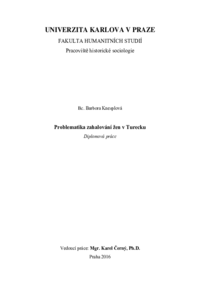Problematika zahalování žen v Turecku
The Veiling Issue in Turkey Today
diplomová práce (OBHÁJENO)

Zobrazit/
Trvalý odkaz
http://hdl.handle.net/20.500.11956/81811Identifikátory
SIS: 150745
Kolekce
- Kvalifikační práce [6508]
Autor
Vedoucí práce
Oponent práce
Německý, Marek
Fakulta / součást
Fakulta humanitních studií
Obor
Historická sociologie
Katedra / ústav / klinika
Pracoviště Historické sociologie
Datum obhajoby
8. 6. 2016
Nakladatel
Univerzita Karlova, Fakulta humanitních studiíJazyk
Čeština
Známka
Výborně
Klíčová slova (česky)
hidžáb, islám, modernizace, pozápadnění, šátek, Turecko, zahalováníKlíčová slova (anglicky)
headscarf, hijab, Islam, modernization, Turkey, veil, WesternizationTato diplomová práce se zabývá problematikou zahalování žen v Turecku. První teoretická část se snaží zmapovat danou problematiku s důrazem na rozmanité interpretace a vnímání šátku/hidžábu jakožto symbolu, který dnes představuje více než jen islámské náboženství. Tyto rozmanité interpretace byly zapříčiněny především historickým vývojem země, zejména specifickou modernizací Turecka, která byla spojena s pozápadněním. Především díky tomu byl šátek po mnoho let vnímán jako něco zaostalého, nemoderního, jako něco, co nepatří do novodobého Turecka. To mělo za následek, že bylo ženám zákonem zakazováno se zahalovat ve veřejných prostorách. Právě z toho důvodu práce vykresluje daný problém i v historickém kontextu, kdy kořeny této problematiky sahají až do 19. století. Druhá, empirická část je věnována kvalitativnímu výzkumu. Pro účely této práce byly realizovány polostrukturované rozhovory s tureckými vysokoškolskými studentkami, které se zaměřovaly na jejich motivace se (ne)zahalovat a další jevy s tím spojené. Rozhovory byly provedeny jak se zahalenými, tak i s nezahalenými dívkami kvůli možnosti komparace jejich výpovědí. Následně byly rozhovory analyzovány pomocí zakotvené teorie (grounded theory). Klíčová slova: hidžáb, islám, modernizace, pozápadnění, šátek, Turecko, zahalování
This diploma thesis deals with the veiling issue in Turkey. The first theoretical part is trying to map out the issues with an emphasis on the diverse interpretations and perceptions of the scarf / hijab. The work perceives the scarf as a symbol which represents more than just the Islamic religion. These multiple interpretations were caused primarily by the historical development of the country, especially the specific modernization process of Turkey which has been linked to the process of westernization. Mainly because of this the headscarf was for many years regarded as something obsolete, unfashionable. Many people perceived the scarf as something that does not belong in modern Turkey. This situation had affect the veilling issue a lot. Women were prohibited by law to wear a scarf in public areas. For this reason the work shows this issue also in the historical context which goes back to the 19th century - to the Ottoman Empire. The second part comprises the empirical part is devoted to qualitative research. For the purpose of this work interviews with Turkish university students were carried out which focused on their motivation of covering or not covering and other phenomena associated with this topic. Interviews were conducted both with veiled, and with unveiled girls because of the...
